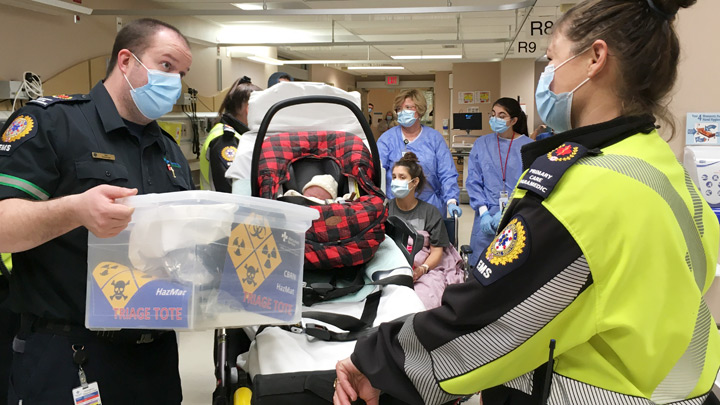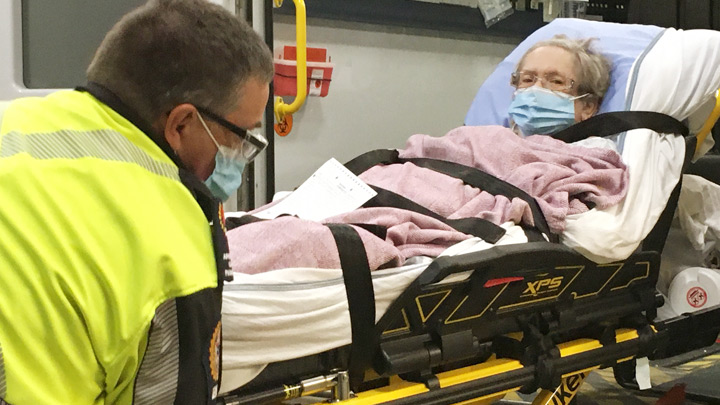
January 4, 2022

A baby is given a smooth, safe move by Alberta Health Services EMS to the new Grande Prairie Regional Hospital (GPRH) from the old Queen Elizabeth II (QEII) Hospital.

Well before sunrise on the morning of Dec. 4, Alberta Health Services launched the largest coordinated patient move in its history — undertaking the delicate task of relocating 99 patients from the old Queen Elizabeth II (QEII) Hospital to the new Grande Prairie Regional Hospital.
Story by Erin Lawrence, Dallas Pierson & Jennifer Sturgeon | Photos by Sara Blake
For many of us, moving involves some boxes, bubble wrap, maybe a few friends and a truck. But when it comes to relocating an entire hospital, there are considerations most of us could never dream of.
Well before sunrise on the morning of Dec. 4, Alberta Health Services (AHS) launched the largest coordinated patient move in its history — undertaking the delicate task of relocating 99 patients from the old Queen Elizabeth II (QEII) Hospital to the new Grande Prairie Regional Hospital (GPRH).
“I believe that this is the first time in Alberta, likely in Canada and possibly even in North America where the ‘lift and shift’ approach was taken to move a hospital — and all the patients — in a single day,” says Darren Sandbeck, senior provincial director and chief paramedic, for Alberta Health Services EMS. “It was an amazing, well-coordinated, teamwork-based success.”
Plans for the big day were drawn up long before that cold winter morning. In fact, contingencies were made to move up to nearly 200 patients, if necessary. Each would require transport by EMS — and it all had to happen in a single day — to ensure a fully operational hospital at the new site.
“Paramedics are very accustomed to fast and huge responses to floods and fires, but the difference with this event was we had time on our side, as we had quite a number of months to plan for this move,” says Rob Barone, associate executive director, AHS EMS North Zone. “We would need to move those patients seven kilometres, through the middle of winter in northern Alberta. We did a lot of planning for every eventuality.”
Logistics and planning brought together representatives of AHS, EMS and all hospital departments — including protective services, pharmacy staff and equipment, porters, contracting, procurement and supply management.
“When you’re moving a hospital patient, there’s additional considerations, and that’s why EMS was so important to the move,” adds Barone. “We needed to ensure medications were available, equipment was connected and brought along, and that anyone who needed care would receive it on the spot.
“But there were also plenty of other important things to consider, such as having Personal Protective Equipment available for everyone involved, plus equipment decontamination, since we were pulling this off during a global pandemic.”
Patient care teams and GPRH planners kept in constant touch with both sites and EMS to share information with all teams taking part in the move.
“I’m always impressed by the way multiple disciplines and departments come together to work through any significant event that impacts AHS,” says Dallas Pierson, special operations supervisor, AHS EMS North Zone.
“We were constantly managing changing circumstances by keeping tabs on how many patients had been moved and how many more were still to come, and (monitoring) each of their conditions through the entire transport process. It was a real team effort between EMS and hospital staff. I couldn’t have been any prouder in terms of how everyone got it done — and done safely — for our patients.”
EMS took into consideration several factors, including an estimate of how long it would take to ready, load and drive each patient — considering their acute-care needs. Time also had to be allowed for EMS crews to don and doff their PPE as well as for the handoff of the patient and proper paperwork to nursing staff at the new hospital.
Extensive “what if” contingency planning also took place.
“We started that planning by taking the full hospital capacity number of 187 patients and dividing it by an 18-hour time frame, just in case we needed that much time,” says Pierson. “We knew this could mean we might have to move 10 patients every hour — that sounds way better than a patient every six minutes. This was the maximum capacity we were ready for.”
The night before the big move, EMS staff from across Alberta converged on Grande Prairie, along with support staff and spare ambulances. In total, 87 EMS staff and paramedics volunteered for this Herculean assignment, ready to make history. In all, 1,192 total AHS staff members contributed to the move, along with 24 physicians and 95 volunteers.
While an influx of patients on the Friday night would have altered logistics, the numbers held steady. By go-time there were 99 patients to move. As the day wore on, busy relocation teams took to calling their mission ‘Operation 99: The Great One-Day Move’ — a nod to hockey legend Wayne Gretzky.
At 6 a.m., EMS transport teams arrived at the old QEII hospital to take the first patients, Kelsi Ching and her newborn, to GPRH by ambulance. Paramedics Crystal Cartwright and Kyla Mosenko did the honours.
“The exceptional teamwork made the day go seamlessly from our perspective”, says Kyla Mosenko, an advanced care paramedic with AHS EMS.
Teams of porters, hospital staff, EMS support staff and leadership watched on as Ching and her child arrived in the first ambulance, then entered the hospital to the sound of bagpipes.
“It took a full 11 hours to transport all the patients,” says Phillip Tautchin, deployment manager, AHS Northern Communications Centre.
“This was definitely a solid example of communication and collaboration between staff and departments, regardless of different fields or backgrounds. It’s definitely helpful when you’re a part of a dynamic group — and everyone rolls up their sleeves and just gets things done!”
The QEII emergency department is now permanently closed. Anyone in need of emergency medical care should go to the new GPRH site, located at 11205 110 St., Grande Prairie.